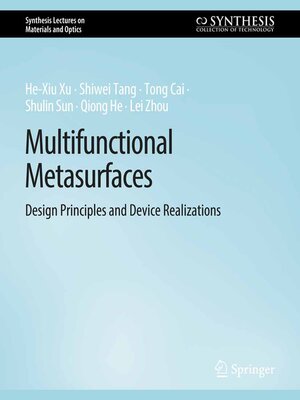Multifunctional Metasurfaces
ebook ∣ Design Principles and Device Realizations · Synthesis Lectures on Materials and Optics
By He-Xiu Xu

Sign up to save your library
With an OverDrive account, you can save your favorite libraries for at-a-glance information about availability. Find out more about OverDrive accounts.
Find this title in Libby, the library reading app by OverDrive.



Search for a digital library with this title
Title found at these libraries:
| Library Name | Distance |
|---|---|
| Loading... |
In recent years, we have witnessed a rapid expansion of using super-thin metasurfaces to manipulate light or electromagnetic wave in a subwavelength scale. However, most designs are confined to a passive scheme and monofunctional operation, which hinders considerably the promising applications of the metasurfaces. Specifically, the tunable and multifunctional metasurfaces enable to facilitate switchable functionalities and multiple functionalities which are extremely essential and useful for integrated optics and microwaves, well alleviating aforementioned issues. In this book, we introduce our efforts in exploring the physics principles, design approaches, and numerical and experimental demonstrations on the fascinating functionalities realized. We start by introducing in Chapter 2 the "merging" scheme in constructing multi-functional metadevices, paying particular attention to its shortcomings issues. Having understood the merits and disadvantages of the "merging" scheme, we then introduce in Chapter 3 another approach to realize bifunctional metadevices under linearly polarized excitations, working in both reflection and transmission geometries or even in the full space. As a step further, we summarizes our efforts in Chapter 4 on making multifunctional devices under circularly polarized excitations, again including designing principles and devices fabrications/characterizations. Starting from Chapter 5, we turn to introduce our efforts on using the "active" scheme to construct multifunctional metadevices under linearly polarized wave operation. Chapter 6 further concentrates on how to employ the tunable strategy to achieve helicity/frequency controls of the circularly polarized waves in reflection geometry. We finally conclude this book in Chapter 7 by presenting our perspectives on future directions of metasurfaces and metadevices.







